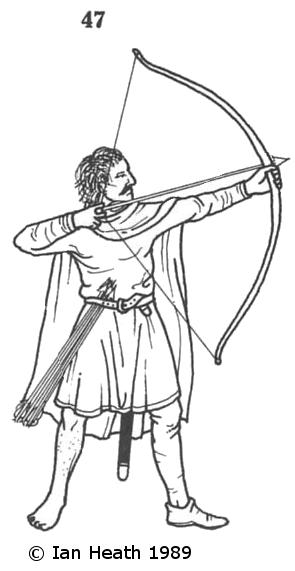WELSH INFANTRYMEN, 11th-13th CENTURIES
An extract from Armies of Feudal Europe 1066-1300by Ian Heath
 |
 |
| [Based on A Latin text of the Laws of Hywel Dda, MS Peniarth 28, mid 13th Century] | [Based on Littere Wallie in Chapter House Liber A] |
 |
 |
| [Based on A Latin text of the Laws of Hywel Dda, MS Peniarth 28, mid 13th Century] | [Based on Littere Wallie in Chapter House Liber A] |
46 & 47. WELSH INFANTRYMEN, 11th-13th CENTURIES
As has already been mentioned, the predominant Welsh troop-types in this period were spearmen in the North and archers in the South, those depicted here being taken respectively from a 12th century Welsh ms. of the 'Laws of Hywel' and an English record book of c.1295 (called simply 'Chapter House Liber A'). Their dress comprised a linen shirt and drawers, and over these a belted woollen tunic reaching to the knees or calves; Giraldus Cambrensis, writing c. 1193/4, adds 'a thin cloak and the observation (repeated by his contemporary, Walter Map) that 'they go barefoot', or else wore shoes of untanned leather 'roughly sewn together'. Even the son of the prince of Gwynedd is described as barelegged and barefoot in 1188, 'and he seemed to care nothing for the thorns and thistles.' Interestingly the 3 Welsh soldiers pictured in 'Liber A' (2 archers and a spearman; for the latter see figure 24 in Armies of the Middle Ages, volume 1) all wear stockings and shoes on their left legs only, the right foot doubtless being kept bare for better purchase on steep hillsides. Giraldus says Welshmen wore their hair short and shaped it round their ears and eyes, though some soldiers actually shaved their heads to avoid getting their hair tangled in low branches while moving through woodlands. They customarily shaved their chins too, but many wore moustaches.
Though Giraldus describes Welsh spears as 'very long', they were nevertheless occasionally 'thrown a short distance like a javelin', under which circumstances no mail corselet was proof against them. He records the men of Merionethshire and Cynan as being particularly skilful in the use of the spear, while the best archers were those from Gwent, who he describes as having much more experience of warfare than the men from other parts of the country. In his 'Journey through Wales', written in 1188, Giraldus describes Welsh elm bows as crude ('rough and unpolished') but capable of firing to a considerable distance, as well as being able to inflict deep and savage wounds at close range. He cites an anecdote in which arrows fired from such bows penetrated an oak door 4″ thick, and tells how on another occasion an arrow went through a horseman's mail cuisse and the skirt of his gambeson, then through his leg and saddle, and finally penetrated deep enough into his horse's flank to kill it. As a result of such experiences the English were quick to recognise the military potential of Welsh archers, who consequently served in many English armies of the 12th and 13th centuries, featuring particularly prominently in Edward I's reign and, earlier, in the Anglo-Norman invasion of Ireland, where Earl Richard de Clare inherited his father's nickname 'Strongbow' because of them. Indeed, it was from the Welsh that the famous English longbow of the later Middle Ages was adopted.